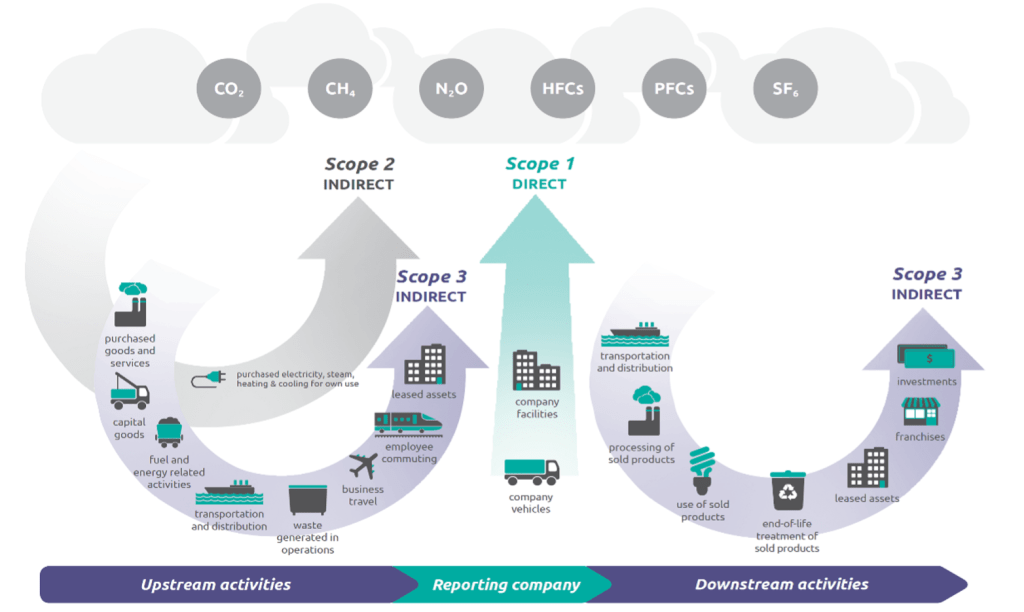Envetec Insight
What Scope Does Waste Belong to?
Understanding Waste Emissions: Scope 1, 2, and 3 Explained
When businesses evaluate their environmental impact, they report emissions under three categories: Scope 1, Scope 2, and Scope 3. These scopes help standardise carbon accounting, ensuring companies fully understand their emissions footprint. For those new to the topic of carbon emissions, understanding these scopes is crucial for effective environmental management.

(Source: https://ghgprotocol.org/sites/default/files/standards/Corporate-Value-Chain-Accounting-Reporing-Standard_041613_2.pdf)
Breaking Down Scope 1, 2, and 3 Emissions
- Scope 1 Emissions: These are direct emissions from sources a company owns or controls. This includes emissions from burning fuel on-site, company vehicles, and industrial processes.
- Scope 2 Emissions: These are indirect emissions from purchased energy, such as electricity, steam, heating, and cooling.
- Scope 3 Emissions: This category includes all other indirect emissions that occur in a company’s value chain, from supply chain emissions to the carbon footprint of waste disposal.
Where Does Waste Fit Within These Scopes?
While waste is easily identified, its place within the scope definitions can be less clear. It often depends on the activities surrounding the waste.
Scope 1: Waste from On-Site Operations
If a company processes waste on-site—for example, through incineration or thermal pre-treatment (like autoclaves)—any emissions produced are considered Scope 1. This is common in manufacturing facilities, hospitals, and industrial sites where waste is treated in-house. This can include biohazard waste that requires immediate waste treatment.
Scope 2: Waste and Purchased Energy
While waste itself isn’t directly part of Scope 2, the energy used to manage waste can contribute. If a facility uses electrically powered waste compactors or heat treatment systems, the energy consumption contributes to Scope 2 emissions. This is relevant for facilities managing clinical waste collection that requires energy-intensive processes.
Scope 3: Waste Disposal and Supply Chain Waste
Most waste-related emissions fall under Scope 3 because they occur outside the company’s direct control. This includes:
- Emissions from waste transportation to landfills or waste recycling centres.
- Greenhouse gas emissions from landfill or incineration.
- Supplier waste generation, such as packaging waste from purchased materials.
Given that Scope 3 is often the largest emissions category, businesses aiming to improve sustainability should carefully consider their waste management strategies. This is particularly important for biohazardous waste recycling and other specialised waste treatment processes.
The Importance of Understanding Waste Emissions
Understanding where waste emissions fall within the Scope 1, 2, and 3 framework helps businesses make informed decisions about waste reduction, waste recycling, and sustainable disposal methods. By reducing waste and choosing lower-carbon disposal methods, companies can lower their emissions, improve their Environmental, Social, and Governance (ESG) performance, and meet regulatory requirements like the EU’s Corporate Sustainability Reporting Directive (CSRD). This is especially relevant for regulated waste treatment companies in Ireland and the UK.

Final Thoughts: Waste as a Key Factor in Carbon Footprint
Waste is more than just an operational byproduct; it’s a key factor in a company’s overall carbon footprint. Whether it falls under Scope 1, 2, or 3, businesses that prioritise waste reduction and responsible disposal will benefit from lower emissions, improved compliance, and a stronger sustainability strategy. Understanding where waste fits in emissions reporting is the first step towards making more sustainable choices, particularly for biohazardous waste treatment companies.
Previous article